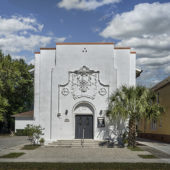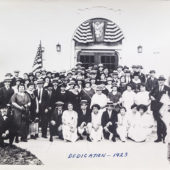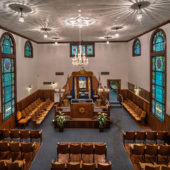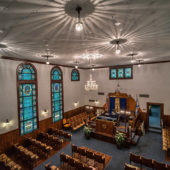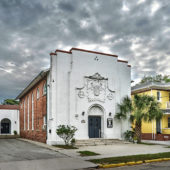The oldest continuously used synagogue sanctuary in Florida.
In 1889 H.M. Flaggler, who was responsible for much of Florida’s early development and railroad, made a major donation towards a $25,000 synagogue for St. Augustine. Eventually the synagogue was built and dedicated on March 30th 1924. It is the oldest continuously used synagogue sanctuary in Florida.
The Spanish style white stucco façade and striking stained glass windows are the most outstanding features of the building. At one time the building included a mikvah and there is still a balcony that was originally for women. The windows were created between 1889 and 1890 for Ahawas Achim, an Orthodox synagogue in Atlanta. In the 1950s the windows were salvaged when the synagogue was torn down for the construction of Interstate 75. In 2013 the windows were restored once again at a cost of nearly $30,000.
St. Augustine, Florida, was founded September 8th, 1565 by Pedro Menendez de Avila. It is the oldest continuously occupied European-established settlement in the United States. The St. Augustine Historical Society is investigating the possibility that the first Jews to arrive in the city arrived with Menendez de Avila in the first weeks of 1565. If that is correct, the Jews were Marranos, Jews who outwardly practiced Catholicism, but privately practiced Judaism in order to escape the Spanish Inquisition.
There are a number of clues which point to the possibility that some of those early arrivals were in fact Jewish. According to Rabbi Merrill Shapiro of First Congregation Sons of Israel:
* Burials at the original Nombre de Dios Mission. Some are buried with their feet toward the altar of the church and others are buried facing east. No one is quite certain why. It’s a common Jewish custom in North America and Spain to bury the dead with the feet facing toward the east and Jerusalem.
* Pedro Menendez’ wife was Maria Solis. Her brother commanded the fleet that arrived off St. Augustine on Aug. 28, 1565. Solis can be a name referring to a place in Spain, but it is also a common Jewish name.
* Menendez waited until Sept. 8, 1565, to come ashore and claim the region for Spain. The group wonders if he was waiting until the day after Yom Kippur, the Jewish Day of Atonement described in the biblical book of Numbers, Chapter 29.

